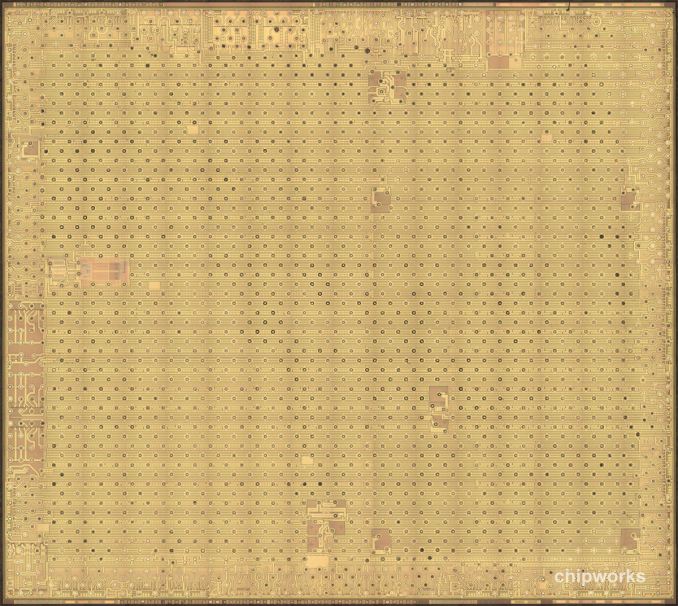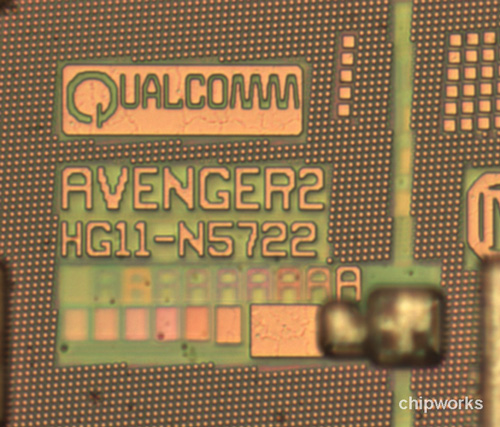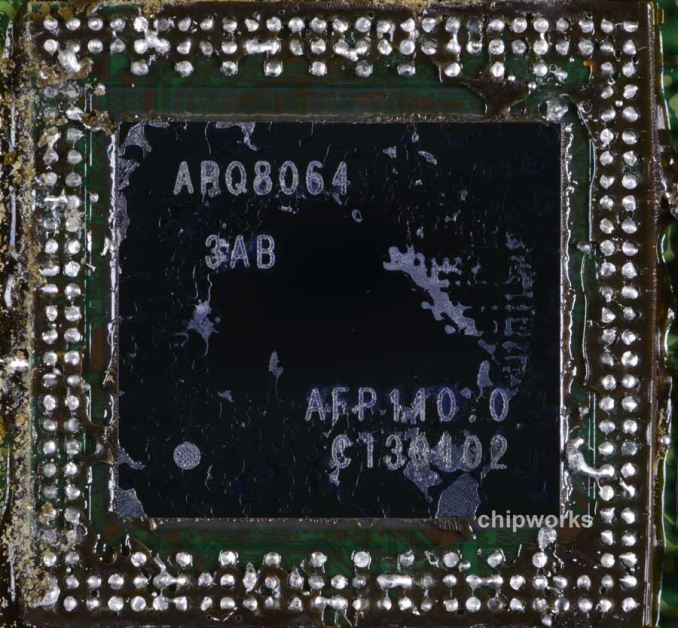Samsung Galaxy S 4 Review - Part 1
by Brian Klug on April 24, 2013 12:01 AM ESTGalaxy S 4 - Powered by a Better Snapdragon 600 (APQ8064AB)?
At a high level, Samsung's Galaxy S 4 integrates Qualcomm's Snapdragon 600 SoC. From what Qualcomm told us about Snapdragon 600, we're dealing with four Krait 300 cores and an Adreno 320 GPU. The Krait 300 cores themselves are supposed to improve performance per clock over the original Krait CPU (Krait 200) through a handful of low level microarchitectural tweaks that we've gone through here. The Krait 300 design also allegedly improves the ability to run at higher frequencies without resorting to higher voltages. This isn't the first time we've talked about Snapdragon 600, but since then a few things have come to light.

Snapdragon 600 from HTC One - Chipworks
For starters, Chipworks got their hands on a Snapdragon 600 SoC (from an HTC One) and delayered the SoC. In its investigation, Chipworks discovered that Snapdragon 600 had the exact same die area as the previous generation Snapdragon S4 Pro (APQ8064). Also, although you'd expect APQ8064T markings on the chip itself, the part carried the same APQ8064 label as previous S4 Pro designs.

Avenger 2 Markings on Snapdragon 600 die from HTC One - Chipworks
Chipworks did note however that there were some subtle differences between a standard APQ8064 and the Snapdragon 600 SoC from the HTC One. The Snapdragon 600 from the One is labeled with an Avenger2 codename rather than Avenger, the latter was apparently present on prior APQ8064 designs. Chipworks also noticed differences in the topmost metal layer, although it's not clear whether or not they stopped there or found no differences in lower layers.
All of this points to a much more subtle set of physical differences between APQ8064 and the earliest Snapdragon 600s. Metal layer changes are often used to fix bugs in silicon without requiring a complete respin which can be costly and create additional delays. It's entirely possible that Krait 300 was actually just a bug fixed Krait 200, which would explain the identical die size and slight differences elsewhere.
That brings us to the Galaxy S 4. It's immediately apparent that something is different here because Samsung is shipping the Snapdragon 600 at a higher frequency than any other OEM. The Krait 300 cores in SGS4 can run at up to 1.9GHz vs. 1.7GHz for everyone else. Curiously enough, 1.9GHz is the max frequency that Qualcomm mentioned when it first announced Snapdragon 600.
Samsung is obviously a very large customer, so at first glance we assumed it could simply demand a better bin of Snapdragon 600 than its lower volume competitors. Looking a bit deeper however, we see that the Galaxy S 4 uses something different entirely.
APQ8064 from a Snapdragon 600 based HTC One - Chipworks
Digging through the Galaxy S 4 kernel source we see references to an APQ8064AB part. As a recap, APQ8064 was the first quad-core Krait 200 SoC with no integrated modem, more commonly referred to as Snapdragon S4 Pro. APQ8064T was supposed to be its higher clocked/Krait 300 based successor that ended up with the marketing name Snapdragon 600. APQ8064AB however is, at this point, unique to the Galaxy S 4 but still carries the Snapdragon 600 marketing name.
If we had to guess, we might be looking at an actual respin of the APQ8064 silicon in APQ8064AB. Assuming Qualcomm isn't playing any funny games here, APQ8064AB may simply be a respin capable of hitting higher frequencies. We'll have to keep a close eye on this going forward, but it's clear to me that the Galaxy S 4 is shipping with something different than everyone else who has a Snapdragon 600 at this point.











335 Comments
View All Comments
Solandri - Thursday, April 25, 2013 - link
Structural engineer here. The reasons Roffles12 cited are valid, objective engineering reasons to use plastic over metal. When you're designing an item and selecting what material it's made of, a myriad of factors come into play including: elastic modulus (flexibility), toughness (ability to withstand piercing), hysteresis (energy absorbed during bending vs. energy bounced back), yield strength (how much stress it can take before it breaks), fatigue (tendency for cracks to grow), fracture strength (tendency for cracks to propagate), corrosion resistance, heat and electrical conductivity, thermal expansion, weight, density, and yes cost.For a phone with an expected 2-3 year lifespan (plastic tends to get brittle after many years), plastic is actually superior to metal in many of these characteristics. A similar thing happened in the 1940s and 1950s with cars. As they got faster, more people were dying in accidents. Automakers responded by building the cars stronger and stronger, and more people died. Finally they took a step back and did some crash testing, and found that making the exterior stronger was actually the *worst* thing they could do to protect the people inside. It transmitted all the impact forces directly to the occupants. Now they build cars with crumple zones which bend and yield to absorb the energy of an impact, while a stiff passenger compartment protects the occupants. Similarly, if designed right, a phone with a flexible plastic exterior but a strong interior construction can survive impacts better than one with a stiff metal exterior.
Unfortunately, for most of the uneducated masses, their analysis is much simpler: metal = good, plastic = cheap. Which is really too bad since it will lead to them making a lot of non-optimal purchase decisions. About the only plastic which has escaped this stereotype is carbon fiber, which is just strengthening fibers embedded in a plastic substrate. Probably because the stuff is expensive, and most people automatically assume expensive = good.
UpSpin - Thursday, April 25, 2013 - link
I normally don't sit in my smartphone and throw it with 100 km/h against a wall. And I don't know a car made out of plastic, the cars I drive are made out of steel and aluminum and last more than 10 years.I don't understand what you want to tell us at all with your car story, because it's not related to smartphones at all.
You also forget that the front of the smartphone consists of glass! which breaks easily. So if your body is highly flexible and very soft, it won't break, but your glass will have to absorb the whole energy and break. And as you can see in the S4 photos, there is barely a bezel thus no 'crush zone'.
You also don't buy a rugged device which must withstand permanent drops. (I haven't dropped my 3 years old smartphone even once).
I agree with you that plastic has its advantages compared to metal but so does metal compared to plastic. Plastic is more flexible which is negligible because the glass isn't flexible. Plastic breaks easily, wheras metal deforms, whatever you prefer.
And as you said, plastic is a broad term. You can find cheap and expensive variants (Kevlar, carbon fiber), with different properties (soft, hard, ...) and different finishes (matt, glossy).
But the plastic (or let's say polycarbonate) Samsung uses is shiny, glossy, cheap.
nerd1 - Thursday, April 25, 2013 - link
Phones get dropped on hard surfaces a lot during its lifetime. Metal gets dent, while polycarbonate ( which is NOT cheap material) absorbs the shock and keeps its shape. If you are gonna baby your phone you may be fine with metal exterior but I do not.gnx - Friday, April 26, 2013 - link
Actually it's not the plastic per se but the additional gloss that makes is bad. The plastic that Samsung uses in their phones is quite high grade, very flexible, very durable. The problem is the shiny gloss they put on top of it. I think in an interview Samsung said they add the glossy finish cause it prevents scratches and provides a halo effect. Both personally dislike both, since the instead of scratches it attracts finger prints, and the halo effect is just distracting. I wouldn't mind plastic at all, even prefer if, plastic if they'd leave it matte.Osamede - Friday, April 26, 2013 - link
"...You also forget that the front of the smartphone consists of glass! which breaks easily. So if your body is highly flexible and very soft, it won't break, but your glass will have to absorb the whole energy and break...."- This is not accurate. The idea is that the body absorbs energy and transmits less of it. The more solid and less flexible the body, the more the body will transmit the energy further forwarding it to the glass.
"Plastic is more flexible which is negligible because the glass isn't flexible. Plastic breaks easily, wheras metal deforms, whatever you prefer..."
- this is a gross generalization. Metals come in a huge range of properties. Some metals are also brittle (what you refer to as "breaks easily". Even the same metal can be more or less brittle depending on if it is cast or extruded or treated in various ways.
We cant just go around equating looks to durabiity. I can show you plastic body Nokias I have in my drawer that lasted years and could last another half decade if I take it out and use it today. Plastic body with a metal frame under or even just plastic body/frame can be highly effective and long lasting in protecting what's inside, even if it scratches.
We need to stop generalizing like this. It's beyond shallow. This is engineering - there are many ways to skin a cat and acheive a specific type of durability, at various tradeoffs and price points.
If you like the phone - fine, buy it. If you dont, then hey buy what you like. Free choic.
A_Smith - Thursday, April 25, 2013 - link
Features and other specs wise this phone is on top, but I'm not happy with its design. Samsung has kept rolling their newer model with almost similar designs for years now. Aren't they planning to modify their smartphone designs?Jaegs - Thursday, April 25, 2013 - link
Anandtech doesn't do review scores so we have to use "Klug Pages"HTC One is 17
Galaxy S4 is 9
ShieTar - Thursday, April 25, 2013 - link
I am somewhat surprised that the articles does not discuss the apparently protruding camera optics in more detail. I have a Huawei Mediapad with a similar protruding lens fixation, and it is rather annoying because it wobbles around if you lay it down on a table. For me that is actually a relevant point, even for a phone. About 7 hours a day, the phone is lying on my table while I work, and if a text or Mail comes in, I don't actually pick it up, but rather just operate it on the table.Is this possible with the Samsung, or is the protruding optics a problem?
I also wish that someone would make a great smartphone without cameras, which I never used in my life, but I'm getting the distinct feeling that I am the only person alive with that problem.
richy184 - Thursday, April 25, 2013 - link
Yep, HTC One for me. GS4 is just too cheap and tacky looking (software and hardware) with too many gimmicky features ill never ever use.krumme - Thursday, April 25, 2013 - link
I am surprised Brian had an micro sd card :) - naughty